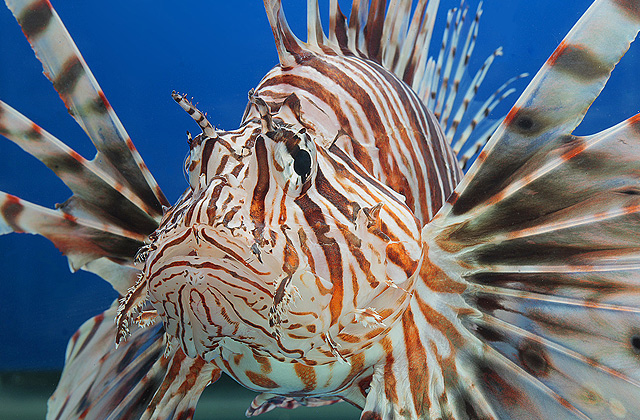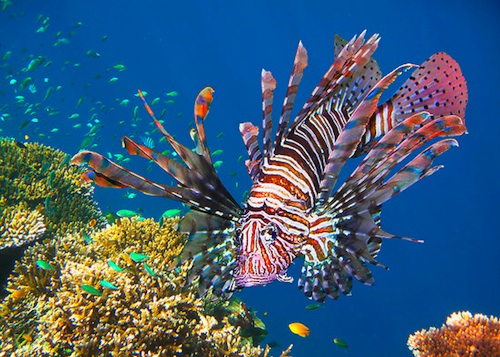
Pterois volitans
FAMILY
Scorpaenidae
TAXONOMY
Pterois volitans Linnaeus, 1758, Moluccas Island, Indonesia.
OTHER COMMON NAMES
English: Volitan lionfish, butterfly cod, red firefish, turkeyfish;
French: Poisson volant; German: Rotfeuerfisch; Japanese:
Hana-minokasago, ominokasago.
PHYSICAL CHARACTERISTICS
Reaches 13.8 in (35 cm) maximum length. One of the most
easily recognized of all marine fishes. The most striking features
of the red lionfish are its banded (reddish to black) head
and body and its unique pectoral configuration. The long,
flowing pectoral rays have varying degrees of connecting membranes,
giving them the distinctive appearance of separate
threadlike projections. The dorsal and anal fins are covered
with dark rows of spots on a clear to yellowish background. All
of the non-pelvic spines—these include the pectoral, anal, and
dorsal spines—are venomous.
DISTRIBUTION
A wide-ranging species found throughout the Indo-Pacific region.
Recently, populations of the red lionfish have become established
on the Atlantic coast of the United States,
presumably released by aquarium wholesalers in Florida following
Hurricane Andrew in 1992. This introduced species has
been collected from the Florida Keys north to North Carolina
and the southern coast of Long Island, New York.
HABITAT
Usually found in lagoon and seaward reefs. Typically, it is a
fairly shallow-water species, but it can be found as deep as 164
ft (50 m). They tend to hide among rocks or in caves during
the day.
BEHAVIOR
The audacity of the colors of this species is a clear warning
sign for its exceedingly venomous spines. This species flexes its
pectoral fins quickly to charge aggressors with its extended
dorsal spines.
FEEDING ECOLOGY AND DIET
This species, like most species of Pterois, is a voracious predator
that feeds primarily on small fishes, shrimps, and crabs. It
has been reported that it can eat as much as 8.2 times its body
weight per year. Feeds primarily at night, when it uses its
widespread pectoral fins to trap prey into a corner. Preyed
upon by humans.
REPRODUCTIVE BIOLOGY
Primarily solitary, but a single male forms aggregations with
females for mating. Courtship begins at twilight and is initiated
by the male. Females generally produce two tubes composed of
mucus and between 2,000 and 15,000 eggs. Shortly after the
females release the eggs, the tubes swell with seawater and are
penetrated by the male’s sperm. Fertilization proceeds, and the
larvae hatch after 36–48 hours.
CONSERVATION STATUS
Not listed by the IUCN.
SIGNIFICANCE TO HUMANS
Collected in large numbers for the aquarium trade. Despite its
venomous nature, the red lionfish also is harvested commercially
for food.
Other popular Animals
Photo Gallery of - Red lionfish





 Animalia Life
Animalia Life